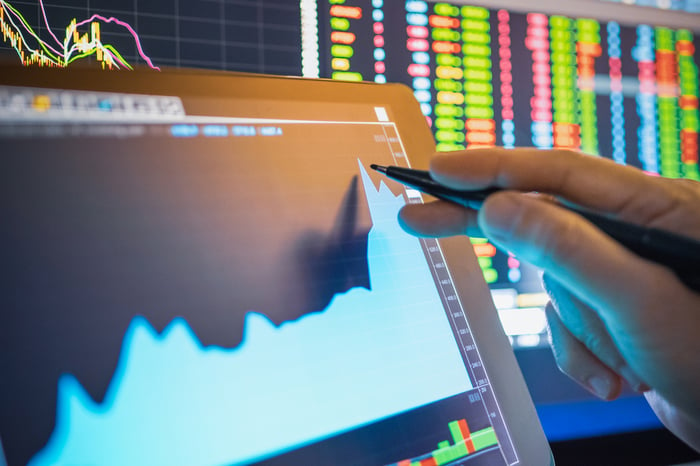Since this decade began, Wall Street's major stock indexes have oscillated between bear and bull markets in successive years. When volatility arises, investors have a tendency to seek out the safety of the market's top-performing businesses. Over the past year, the "Magnificent Seven" have fit the bill.
Aside from sporting well-defined competitive advantages, these seven components have handily outperformed the benchmark S&P 500 over the trailing decade. Currently, all but one of the Magnificent Seven members have a trillion-dollar market cap. The all-important question is: Which companies are next to join the exclusive trillion-dollar club?

Image source: Getty Images.
While no one knows this answer with any certainty, a strong argument can be made that the following five companies will reach the $1 trillion mark before 2030.
1. Berkshire Hathaway: Current market cap of $904 billion
At the pace it's been taking out its previous all-time high, the conglomerate Warren Buffett runs, Berkshire Hathaway (BRK.A 0.12%) (BRK.B -0.06%), may not even need until the end of 2024 to reach the illustrious $1 trillion level. Since becoming CEO of Berkshire nearly six decades ago, the affably named "Oracle of Omaha" has guided his company's Class A shares (BRK.A) to a nearly 20% annualized return.
Berkshire Hathaway's overwhelming outperformance of the benchmark S&P 500 since the mid-1960s can be boiled down to three factors: Warren Buffett's love of cyclical stocks, dividend payers, and portfolio concentration.
With regard to former, Buffett and his top investment aides, Ted Weschler and Todd Combs, fully understand that recessions are a normal and unavoidable aspect of the U.S. economic cycle. However, they'd never bet against America. That's because periods of growth last significantly longer than economic downturns. Buffett and his team have packed Berkshire's $370 billion investment portfolio with cyclical businesses that benefit from sustained growth in the U.S. and global economy.
Secondly, Berkshire Hathaway's investment portfolio contains well over two dozen dividend-paying stocks. A recently updated study by the Hartford Funds, in collaboration with Ned Davis Research, found that dividend payers averaged an annual return of 9.17% over roughly 50 years (1973-2023), compared to a more modest 4.27% annualized return for public companies that didn't offer a dividend. Companies that regularly share a percentage of their earnings with their investors are typically profitable on a recurring basis and time-tested.
Lastly, Warren Buffett and his team have put a majority of Berkshire's invested capital to work in a relatively small number of companies. Despite holding stakes in 45 stocks and two index funds, Berkshire's top investment minds firmly believe that their best investment ideas require extra weighting. These outperformers, which includes top holding Apple, have crushed it over the long run.
2. Taiwan Semiconductor Manufacturing: $733 billion
A second game-changing businesses that has a realistic shot at achieving a trillion-dollar market cap before 2030 is world-leading chip fabrication company Taiwan Semiconductor Manufacturing (TSM -0.17%). As you can see from its current valuation, Taiwan Semi only needs a modest 36% appreciation from here to join the exclusive $1 trillion club.
The obvious catalyst for Taiwan Semiconductor is the artificial intelligence (AI) revolution. It's the leading manufacturing partner for many of the top AI infrastructure providers, including Nvidia, whose graphics processing units (GPUs) maintain around a 90% share in AI-accelerated data centers, and Advanced Micro Devices, whose MI300X GPU is ready to go head-to-head with Nvidia's H100 GPU.
Taiwan Semi should also benefit from technological advancements occurring outside the traditional tech space. For example, next-generation vehicles are incorporating technology at a rapid pace. As these vehicles become more reliant on advanced technology, chip fabrication companies like Taiwan Semi will be ideally positioned to benefit.
According to Wall Street estimates, Taiwan Semiconductor's earnings per share (EPS) is forecast to grow by 81% between what was reported in 2023 and what's estimated for 2027. Simply maintaining a forward earnings multiple of 20 would comfortably lift this chip-fab giant to the trillion-dollar plateau.

Image source: Getty Images.
3. Broadcom: $621 billion
The third top-tier company that could reach a $1 trillion valuation before the turn of the decade is semiconductor stock Broadcom (AVGO -0.38%).
Not to sound like a broken record, but much of the gains Broadcom's shareholders have enjoyed over the trailing year are related to its role in the AI revolution. In April of last year, Broadcom unveiled its Jericho3-AI chip, which can connect up to 32,000 high-powered GPUs in high-compute data centers. This seamless connectivity is what's needed to train large language models and oversee generative AI solutions.
But there's far more to Broadcom than just an acceleration of its sales from AI. This company's foundation has long been the wireless chips and accessories it provides for next-generation smartphones. When wireless carriers upgraded their networks to support 5G speeds, it provided a multiyear catalyst for consumers and businesses to swap out their old units for new devices that can take advantage of these faster speeds. This cash cow of a segment remains important to Broadcom's success.
Similar to Taiwan Semi, Broadcom is also benefiting from technological advancements outside of traditional data centers. It provides an assortment of automotive solutions, ranging from advanced driver assistance systems and body electronics, to enterprise software solutions that can help large-scale businesses meet their key performance indicators.
Even if the AI bubble were to burst between now and the turn of the decade, Broadcom has the foundational catalysts needed from other segments to weather the storm and come out stronger.
4. and 5. Visa and Mastercard: $569 billion (Visa), $445 billion (Mastercard)
The fourth and fifth game-changing businesses that can reach a $1 trillion valuation before 2030 are payment processors Visa (V -0.70%) and Mastercard (MA -1.07%). The reason I've chosen to discuss both companies together is because they share the same catalysts and have very similar operating models.
Visa and Mastercard are the perfect examples of cyclical companies that benefit from long-winded expansions (and they're both holdings in Berkshire Hathaway's portfolio). Whereas only three of 12 recessions since the end of World War II have endured at least 12 months, almost every economic expansion over the same span has lasted multiple years. Long periods of growth mean consumers and businesses will spend more, which is great news for fee-driven payment processors like Visa and Mastercard.
Both companies also have sustained growth runways. In addition to Visa and Mastercard being the respective No.'s 1 and 2 in credit card network purchase volume in the U.S., the largest market for consumption globally, they have a multidecade opportunity to organically or acquisitively expand their payment infrastructure into underbanked emerging markets. This includes the Middle East, Africa, and Southeastern Asia.
Something else that's undeniably important to Visa's and Mastercard's success is their purposeful avoidance of lending. Although both companies would almost certainly be successful if they became lenders, doing so would expose them to credit delinquencies and loan losses during recessions. Since they're solely focused on payment facilitation, they aren't required to set aside capital during periods of economic instability. In other words, Visa and Mastercard typically bounce back from downturns faster than most lending institutions.
Consensus EPS forecasts for 2027 project aggregate earnings growth of 62% for Visa and 85% for Mastercard, relative to what both companies reported in 2023. If both can sustain their double-digit EPS growth rates, they can each join the exclusive $1 trillion club before 2030.





